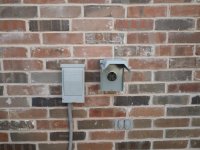TxCowboy
Well-known member
My RV is packed at home currently and, from time to time, we use it as a guest room.
We currently have it hooked to home shore power, 120V, 20 amp service (an external patio plug) via a 75 foot long, 12 AWG copper insulated extension cord (from Home Depot). That extension cord is plugged into a 30 amp adapter which is then plugged into a 50 amp adapter when is then plugged into the standard 20 foot 50 amp power cable (the one that came with my Greystone RV).
A friend of mine, a HVAC guy, is telling me that this setup is going to kill my RV electrical system, particularly the air conditioner. He basically said that, even though the RV is getting the full 120 Vac, the distance (probably a total of 100 feet) with an extension cord is going to drop the amps down to where it will damage the AC and other alternating current appliances.
Short of cutting open the extension cord to test it, is there a way (mathematically?) to compute the amount of amps that are actually reaching the RV?
Help!!
We currently have it hooked to home shore power, 120V, 20 amp service (an external patio plug) via a 75 foot long, 12 AWG copper insulated extension cord (from Home Depot). That extension cord is plugged into a 30 amp adapter which is then plugged into a 50 amp adapter when is then plugged into the standard 20 foot 50 amp power cable (the one that came with my Greystone RV).
A friend of mine, a HVAC guy, is telling me that this setup is going to kill my RV electrical system, particularly the air conditioner. He basically said that, even though the RV is getting the full 120 Vac, the distance (probably a total of 100 feet) with an extension cord is going to drop the amps down to where it will damage the AC and other alternating current appliances.
Short of cutting open the extension cord to test it, is there a way (mathematically?) to compute the amount of amps that are actually reaching the RV?
Help!!


